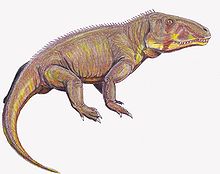| Shansisuchus Temporal range: Middle Triassic, 247.2–242.0 Ma PreꞒ Ꞓ O S D C P T J K Pg N | |
|---|---|

| |
| Skeletal cast mount, Paleozoological Museum of China | |
| Scientific classification | |
| Domain: | Eukaryota |
| Kingdom: | Animalia |
| Phylum: | Chordata |
| Class: | Reptilia |
| Clade: | Archosauromorpha |
| Clade: | Archosauriformes |
| Family: | †Erythrosuchidae |
| Genus: | †Shansisuchus Young, 1964 |
| Type species | |
| †Shansisuchus shansisuchus Young, 1964 | |
| Species | |
| |
Shansisuchus (meaning "Shanxi Province crocodile") is an extinct genus of archosauriform reptile belonging to the family Erythrosuchidae that lived during the Middle Triassic in what is now China. The first fossils of Shansisuchus were discovered from the Ermaying Formation of Shanxi (Shansi) province in 1964 by Chinese paleontologist Yang Zhongjian. Like other erythrosuchids, Shansisuchus was a large-bodied carnivore with a large, deep skull. Shansisuchus is unique among early archosauriforms in having a hole in its skull called a subnarial fenestra.
Description

Shansisuchus is a large erythrosuchid distinguished from other members of the group by two characters: a tongue-and-groove articulation between the premaxilla and nasal bones of the skull and the presence of a subnarial fenestra. In Shansisuchus the premaxilla, a bone that makes up the front of the snout, projects backward and fits into a groove in the nasal, a bone that makes up the top of the snout. The subnarial fenestra is present between the external nares (nasal opening) and the antorbital fenestra, a hole in front of the eye socket. It is separated from the antorbital fenestra by a vertical projection of the maxilla bone. A subnarial fenestra is present in a few other more derived archosauriforms such as some dinosaurs and pseudosuchians, but its morphology in Shansisuchus is unique.
History of research
Shansisuchus is known from many fossil skeletons representing more than a dozen individuals, making it one of the best known erythrosuchids. However, all but one specimen discovered in 2010 (a complete skull and 14 vertebrae from Jixian County) are disarticulated, meaning that many aspects of its anatomy had been poorly understood before that specimen was described. Most specimens have been found in a fossil locality in Wuxiang County, and others have been found in localities in Ningwu, Yushe, Jingle, and Xing counties. Three species of Shansisuchus have been named: the type species Shansisuchus shansisuchus, which is known from over ten individuals; S. heiyuekouensis, which is known from five individuals; and S. kuyeheensis, which is known from one individual.
Relationships

Shansisuchus belongs to a group of reptiles called Archosauriformes, which is today represented by crocodilians and birds but also includes a diversity of extinct forms extending back to the Late Permian. It is a basal archosauriform that lies outside Archosauria, the crown group originating with the last common ancestor of birds and crocodilians. When Shansisuchus was first described, Yang placed it in its own family, Shansisuchidae. In 1992 Shansisuchus was reassigned to the family Erythrosuchidae and proposed to be the closest relative of the genus Vjushkovia (now considered a synonym ofGarjainia). A phylogenetic analysis published in 2013 found that Vjushkovia was more closely related to Erythrosuchus, and that Shansisuchus lied outside the Vjushkovia+Erythrosuchus clade as a more basal erythrosuchid. Below is a cladogram from the 2013 analysis:
| Archosauriformes |
| ||||||||||||||||||||||||||||||||||||||||||||||||||||||||||||
References
- ^ "†Shansisuchus Young 1964". Paleobiology Database. Fossilworks. Retrieved 18 May 2023.
- ^ "Shansisuchus - a prehistoric reptile discovered in China". All Wild Animals. Retrieved 6 October 2013.
- ^ Wang, F.; Xu, S.; Wu, X.; Li, C.; Wang, S. (2013). "A new specimen of Shansisuchus shansisuchus Young, 1964 (Diapsida: Archosauriformes) from the Triassic of Shanxi, China". Acta Geologica Sinica. 87 (5): 1185–1197. doi:10.1111/1755-6724.12145. S2CID 128818375.
- Parrish, J. M. (1992). "Phylogeny of the Erythrosuchidae (Reptilia: Archosauriformes)". Journal of Vertebrate Paleontology. 12: 93–102. doi:10.1080/02724634.1992.10011434.
| Archosauromorpha | |||||||||||||||||||||||||||||||||||||||||
|---|---|---|---|---|---|---|---|---|---|---|---|---|---|---|---|---|---|---|---|---|---|---|---|---|---|---|---|---|---|---|---|---|---|---|---|---|---|---|---|---|---|
| |||||||||||||||||||||||||||||||||||||||||
| |||||||||||||||||||||||||||||||||||||||||
| |||||||||||||||||||||||||||||||||||||||||
| Taxon identifiers | |
|---|---|
| Shansisuchus | |


